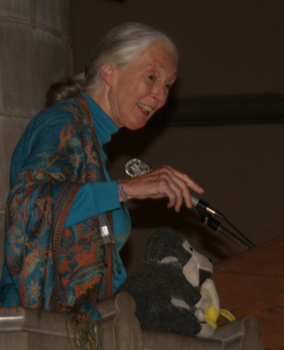| Sun | Mon | Tue | Wed | Thu | Fri | Sat |
|---|---|---|---|---|---|---|
| 1 | 2 | 3 | 4 | 5 | ||
| 6 | 7 | 8 | 9 | 10 | 11 | 12 |
| 13 | 14 | 15 | 16 | 17 | 18 | 19 |
| 20 | 21 | 22 | 23 | 24 | 25 | 26 |
| 27 | 28 | 29 | 30 | 31 |
CATEGORIES
RECENT ENTRIES
BLOG ROLL
From scientist to activist
Jane Goodall's journey continues, preaching hope for the future of the planet as she protects chimps and their habitats.
 “Sometimes to save the place you love, you have to leave the place you love.” That’s what primatologist Jane Goodall told a capacity crowd last month at Rockefeller Chapel, concluding a talk on humans, their closest animal cousins, and the uncertain future of Africa’s equatorial forest.
“Sometimes to save the place you love, you have to leave the place you love.” That’s what primatologist Jane Goodall told a capacity crowd last month at Rockefeller Chapel, concluding a talk on humans, their closest animal cousins, and the uncertain future of Africa’s equatorial forest.
In 1986, Goodall left Gombe National Park, after having spent nearly her whole adult life there studying chimpanzees to whom she gave names like Goliath and David Greybeard and Flo and Freud. Since then, she hasn’t stayed anywhere for more than three weeks at a time; instead, she travels constantly, campaigning for better treatment of great apes and their disappearing habitats. On the Friday before Mother’s Day, she came to Rockefeller, and as the audience stood and clapped, she swept down the aisle toward the pulpit in a turquoise shawl, surrounded by a flock of paper doves carried aloft by Lab Schools students.
For the next 90 minutes, Goodall talked about her work, recalling her arrival at Tanzania’s Lake Tanganyika—50 years ago this year—as a 26-year-old secretary hired by anthropologist Louis Leakey and chaperoned by her mother. Struck by her passionate curiosity about African wildlife, Leakey had invited Goodall to do a field study of chimpanzees in western Tanzania. “I would have done anything,” Goodall said, “I would have studied any animal to be out in the bush.”
And so, her adventure began. As a renowned, sometimes controversial researcher, Goodall watched chimpanzees parenting their offspring and modifying tools to feed themselves. She saw them kiss and pat each other on the back, smile and swagger, hunt for food and attack each other with astonishing violence. She recorded a four-year war that began in 1974 and ended with the annihilation of one whole chimpanzee troop. “What’s clear after 50 years,” she told her Rockefeller audience, “is that chimpanzees help us understand our own position in relation to the rest of the animal kingdom.” Increasingly, it turns out, the difference between us and them is “a very blurry line.”
Goodall decided to depart Gombe after attending a 1986 conference called Understanding Chimpanzees, held in Chicago. Speaker after speaker described the destruction of the African rainforest, the illegal trade in chimpanzee bushmeat, and the cruel treatment of chimps in medical research labs. “It was shocking,” Goodall said. “I went into that conference as a scientist and came out an activist.”
Since then, the Jane Goodall Institute has worked to save the African rainforest and the animals that live there. Its programs rescue orphaned chimps and train “eco-guards” to patrol protected areas; they educate local farmers on sustainable agriculture and distribute microloans to villagers to buy fuel-efficient, tree-saving stoves. Goodall said conservation has also led her to a fight against poverty, “one of the most terrible destroyers of the natural world.” Her Roots & Shoots program enlists schoolchildren all over the world to participate in environmental projects—recycling, cleaning up public parks, volunteering at animal shelters. Young people need to feel involved and hopeful about the world they will inherit, she said; in order to take part in the effort to save the environment, they must believe it can be saved. “If we don’t dare to envision such a world, it will never come."
Before taking a few questions from children in the audience (“Which chimpanzee did you learn from the most?” “Flo,” who raised numerous offspring at Gombe, taught researchers a lot about family relationships and infant development) and retiring to Rockefeller’s foyer to sign books and pose for photos, Goodall closed her talk with a story she often shares, about a chimp named Jo-Jo—orphaned as an infant and raised in captivity—who lost a showdown with another male at the Detroit Zoo and, terrified, jumped into a moat circling the enclosure. He nearly drowned, but a man watching with his family plunged in after Jo-Jo, risking his life to save the chimp, even as the other animals were bearing down on them. In a video of the incident, captured by another zoo visitor, Goodall said, you could see the man, Rick Swope, look at Jo-Jo and then his family and then back at Jo-Jo as he decided to jump over the railing. Later when asked why he did it, Swope said, “I happened to look into his eyes and it was like looking into the eyes of a man. And the message was, ‘Won't anybody help me?’”
Read Jane Goodall's account of Jo-Jo's rescue in full.
Lydialyle Gibson
June 25, 2010
